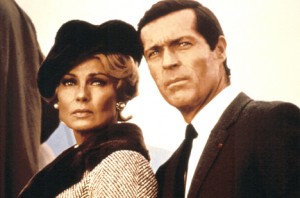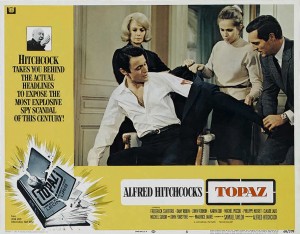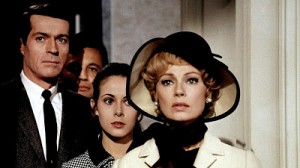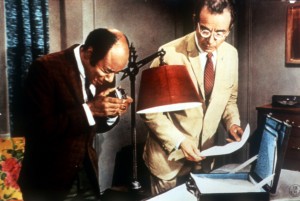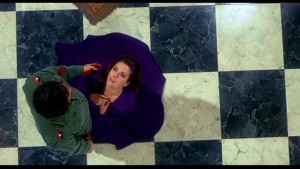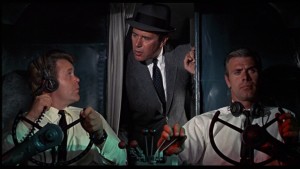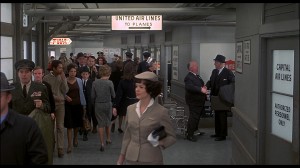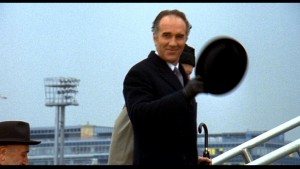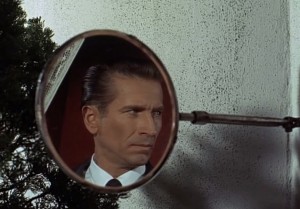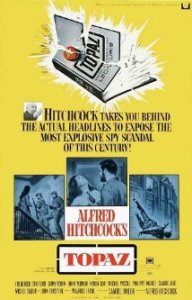Topaz **** (1969, Frederick Stafford, Dany Robin, John Vernon, John Forsythe, Philippe Noiret, Claude Jade, Michel Subor, Michel Piccoli) – Classic Movie Review 463
Alfred Hitchcock’s 1969 spy thriller Topaz is one of his least interesting films, despite being based Leon Uris’s top bestselling novel. But it remains entirely watchable thanks some fine performances and a few typical Hitchcock touches.
Despite being based Leon Uris’s top bestselling spy thriller novel material, Alfred Hitchcock’s 1969 effort Topaz proves to be one of his least interesting films. You can’t help feeling that it should have engaged his imagination as a movie more. Believed to have been forced on him by the studio, it was one his unhappiest directing experiences.
In the lead role, Frederick Stafford is lifeless and uninspired as André Devereaux, a French spy recruited by John Forsythe’s CIA agent Michael Nordstrom to smash a Russian espionage outfit in Cuba in 1962. During debriefing, Nordstrom interviews Soviet intelligence officer Boris Kusenov (Per-Axel Arosenius), a high-ranking Russian official who has just defected to the United States.
After the defector reveals that a Soviet spy ring within the French intelligence service codenamed Topaz is passing NATO secrets to the Russians and that Soviet missiles with nuclear warheads will be placed in Cuba, Nordstrom calls in his old buddy Devereaux to try to expose the French spies and settle the mess in Cuba. Nordstrom sets off for Cuba, alienating his suspicious wife Nicole (Dany Robin), where he meets up with his lover, Cuban patriot Juanita de Cordoba (Karin Dor), who is under the loving protection of Rico Parra (John Vernon), who is in bed with the Russians.
Back safely to the US with Juanita’s all-important microfilms, Kusenov tells Devereaux about the Topaz spy ring and that NATO official Henri Jarré (Philippe Noiret) is leaking documents to the KGB. Devereaux is recalled to Paris, where he sends his son-in-law François (Michel Subor) to interview Jarré and try to make him incriminate himself.
The plot sure is complicated and ambitious, making demands on the audience attention-wise and patience-wise, though a nervous Hitchcock occasionally feels he has to laboriously spell things out to make sure we’ve got the point. The screenplay by
It should be ideal material for Hitchcock, but Topaz is dimmed by dull playing from an interesting non-starry cast of normally good actors who are in many cases ineffectual here, many unconvincing scenes, and a feeling throughout of nervous hesitation that’s odd in a director who was normally so sure of his effects. It’s a pity that Sean Connery turned down the lead because that might have given the film the boost it needs. Frederick Stafford and particularly Dany Robin are quite poor at the centre of the plot. Czechoslovak-born actor Stafford, saddled with a fake French accent, is continually upstaged by the much more expert John Forsythe (reunited with the director from The Trouble with Harry). Dany Robin, disguised in soft focus, emotes like she’s in a silent movie.
But you cannot simply blame some of the actors only. Hitchcock has got the pacing wrong in the editing. It is all too sluggish, slow and ponderous. He does try hard with the visual style, however, filming from odd angles, higher or lower than expected, tracking and swooping in suddenly, swapping from large close-ups to unexpected distance shots, in order to liven things up. It has a stylish surface gloss, with the restored film in lovely condition.
Nevertheless, moderate though Topaz is, it is still a must for Hitchcock’s fans, and it remains entirely, if only sporadically, watchable. That is almost entirely thanks to a handful of notable high points like fine support performances from Per-Axel Arosenius as Boris Kusenov, Roscoe Lee Browne as Philippe Dubois, Michel Piccoli as French spy Jacques Granville, and especially Philippe Noiret as French spy Henri Jarre, plus the smart start as the Russian official defects in Copenhagen with his wife and daughter, and the long Harlem sequence, as well as a few typical Hitchcock arresting visual flourishes and clever touches like the dead woman Juanita de Cordoba (Karin Dor)’s purple dress spilling out like her blood across the floor in an overhead shot.
Typically, Hitchcock tried to experiment, revealing the plot not only though the script but also through the use of colours, mostly red, yellow and white. It is nicely shot by Jack Hildyard, brightly and strikingly, and is interestingly scored by Maurice Jarre, whose rather insistent music is variable from the effective to the inappropriate.
The full version runs an overlong
Leon Uris’s 1967 novel is loosely based on the 1962 Sapphire Affair involving his friend the spy Philippe Thyraud de Vosjoli, the head of France’s Counter-Espionage Service SDECE in the US, who helped the US discover Russian offensive missiles in Cuba.
The story behind the film’s more interesting than the movie, unfortunately.
An unusually dithering Hitchcock shot three endings, all of which were used in different releases, and a video version and a laserdisc show all three. The ending with an old-fashioned pistol duel between André and Jacques in a French football stadium was the original one. This scene was not in the book, but Hitchcock planned it from the start. After finishing principal photography in March, the director took a break, then returned in Paris in mid-April to shoot the climax.
But half way through the week-long shoot, Hitchcock had to leave for America because his wife Alma was taken to hospital. He gave his associate producer Herbert Coleman precise instructions how to shoot rest of the scenes in the duel ending. But in the final cut, the editing of the sequence was a sore point to Hitchcock.
Test screening audiences hated the duel ending and complained the film was far too long. So Hitchcock shot a second ending he liked better, with French spy Jacques Granville (Michel Piccoli) escaping on an Aeroflot flight to the Soviet Union as André and Nicole board their adjacent Pan Am flight back to the US. But confused preview audiences did not like this airport ending either. And it really is a pretty weak ending, subtly ironic maybe, but unsatisfying.
So Hitchcock used existing footage to create a third ending in which Granville is exposed and expelled from a NATO meeting. A gunshot tells he commits suicide behind his drawn curtains since there was no footage of his suicide. This is even more unsatisfying.
The film was released with this third ending and cut by nearly 20 minutes to 127 minutes. The 143-minute cut with the second ending in which Jacques escapes was released for the first time by Universal on DVD in 1999.
Hitchcock appears in his usual cameo about 30 minutes in at the airport getting out of a wheelchair.
Hitchcock won the National Board of Review award for Best Director and Philippe Noiret won for Best Supporting Actor.
The cast
The cast are Frederick Stafford as André Devereaux, Dany Robin as Nicole Devereaux, Karin Dor as Juanita de Cordoba, John Vernon as Rico Parra, Claude Jade as Michèle Picard, Michel Subor as François Picard, Michel Piccoli as Jacques Granville, Philippe Noiret as Henri Jarré, Roscoe Lee Browne as Philippe Dubois, Per-Axel Arosenius as Boris Kusenov, John Forsythe as Michael Nordstrom, Edmon Ryan as McKittreck, Sonja Kolthoff as Mrs Kusenov, Tina Hedström as Tamara Kusenov, John van Dreelen as Claude Martin, Donald Randolph as Luis Uribe, Roberto Contreras as Muñoz, Carlos Rivas as Hernandez, Roger Til as Jean Chabrier, Lewis Charles as Pablo Mendoza, Sándor Szabó as Emile Redon, Anna Navarro as Carlotta Mendoza, Lew Brown as American Official, John Roper as Thomas, George Skaff as René d’Arcy, Ann Doran as Mrs Foryth, and Eva Wilma as Rosita Gomez.
Topaz is directed by Alfred Hitchcock, runs 127 minutes (theatrical cut) or 143 minutes (extended cut), is made by Universal Pictures, is distributed by Universal Pictures. is written by Samuel A Taylor, based on the novel by Leon Uris, is produced by Alfred Hitchcock, is shot by Jack Hildyard, and is scored by Maurice Jarre.
Release date: December 19, 1969 (US).
© Derek Winnert 2013 Classic Movie Review 463
Check out more reviews on http://derekwinnert.com/

